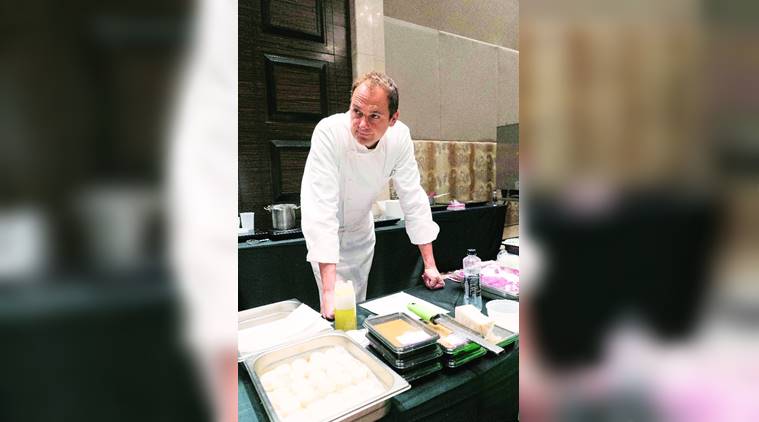 King of the kitchen, Chef Daniel Humm.
King of the kitchen, Chef Daniel Humm.
It was an encounter with Pablo Picasso’s 1945 Bull series, 11 lithographs of the animal at various stages of abstraction, that seeded “the power of less†in Swiss chef Daniel Humm’s approach to his cuisine. “In each successive lithograph, Picasso uses reduction and simplification to create the bull. The last one is a simple line drawing.
For me that was very powerful. The taking away is so much harder than the adding on,†says Humm, whose philosophy to food is largely informed by the minimalist aesthetic.
It is food, with often a monochromatic scheme, simple geometry and only a few ingredients, that is served at Humm’s New York-based Michelin three-starred, Eleven Madison Park (EMP) — which clinched the top spot on the World’s 50 Best Restaurants list last year. Humm, along with restaurateur Will Guidara, bought EMP from David Meyer in 2011 — the same year they received the much-coveted Michelin honour. The duo also co-own two relatively casual concepts: NoMad, inside the eponymous hotel, and Made Nice.
EMP serves a seasonal tasting menu comprising 11 courses that includes Humm’s signature dishes — celery root cooked in a pig’s bladder and honey-glazed duck with turnips and huckleberries. Humm joined the restaurant in 2006 (then still Meyer’s), after working shortly at Campton Palace in San Francisco and apprenticing at Le Pont de Brent, helmed by Gerard Rabaey, in Switzerland. “At the time, that was the best restaurant in Switzerland. Rabaey was an incredible chef,†says Humm, who was in New Delhi for the World Series at the Leela Palace.
After five years of working with Rabaey, Humm moved back closer to Zurich, “to be with friends and family. I literally picked up the newspaper to look for ads and there was one about a person with a small farmhouse and restaurant. I thought that was perfect,†says Humm. It was at this tiny restaurant, Gasthaus zum Gupf in Rehetobel near St Gallen, that he won his first Michelin star at the age of 24. “It all changed so quickly. People started flying in in helicopters to eat at my restaurant. It was insane, and frankly, I wasn’t ready. I was so young and didn’t know what I was doing,†he says.
While his training with Rabaey laid the foundation, Humm’s deep interest in contemporary art influenced the moulding of produce in his hands. It resulted in a distinct culinary vocabulary. Artists Agnes Martin and Robert Ryman come up often in conversation, as he cites another work, Lucio Fontana’s series Spatial Concept ‘Waiting’, which comprises canvases that bear single or multiple cuts to explain his work. “It doesn’t even have paint on it. Just a cut. That’s the kind of work that inspires me. I want to say a lot with very little and it’s very hard. My father’s an architect so I grew up around beautiful objects and design. Most of my friends are artists, and, I realised just interacting with them and their work was my way of finding my voice,†he says.
Humm traces his love and initiation into cooking to his mother, and the time he spent hanging around her kitchen. “My mom is an incredible cook and we spent time together near the kitchen table. One day it was raining hard, and she bought fresh lettuce from the farm — she always insisted on getting the freshest ingredients. The lettuce was full of dirt and she gave it to me to wash. It was difficult but I kept at it — one wash, two washes, five washes, 10 washes. I cribbed throughout because at the supermarket the lettuce sold is already washed and I couldn’t understand why she wouldn’t pick it up from there. Once I was done — and I remember this like it was yesterday — she plucked a leaf out of the bunch and gave it to me to eat. I remember its taste so vividly. It changed who I am. It taught me the worth of taking an extra step, going that extra mile,†says Humm.
For Humm a reverence for good produce, “is crucial, especially with my cooking today, which is very reduced; with very few things on the plate. There is very little room for me to hide anything,†he says.
However, Humm admits, it hasn’t always been easy. “Some points have been very difficult. The 2008 financial crash was one of them. But the word for passion in German is leidenschaft. It means to be willing to suffer for something. That’s what passion is, unlike a hobby,†says Humm.
Take Four
Favourite Ingredient: Salt
Soul Food: Roasted chicken
Favourite Chef: My mom
Word You Use The Most In The Kitchen: Make it Nice